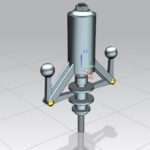The effort of a governor is the mean force exerted at the sleeve for a given percentage
change of speed (or lift of the sleeve). It may be noted that when the governor is running steadily, there is no force at the sleeve. But, when the speed changes, there is a resistance at the sleeve which opposes its motion. It is assumed that this resistance which is equal to the effort, varies uniformly from a maximum value to zero while the governor moves into its new position of equilibrium.
The power of a governor is the work done at the sleeve for a given percentage change of speed.
It is the product of the mean value of the effort and the distance through which the sleeve moves.
Mathematically,
Power = Mean effort × lift of sleeve
The effort and power of a Porter governor may be determined as discussed below. Let N = Equilibrium speed and
c = Percentage increase in speed.Increase in speed = c.N
and increased speed = N + c.N = N (1 + c)
P = Mean force exerted on the sleeve during the increase in speed or the effort of the governor.

If F is the frictional force (in newtons) at the sleeve, then

We have already discussed that the power of a governor is the product of the governor effort and the lift of the sleeve.
Let
x = Lift of the sleeve.
Governor power = P × x



